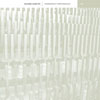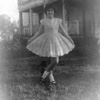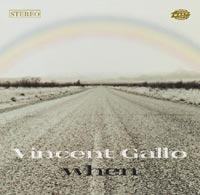 Celebrating the LINE label's status as a separate entity and Chartier's 2010 Smithsonian fellowship (as well as his 40th birthday), Transparency is the document of an hour long performance using the historic Grand Tonometer as it’s primary source. The result is a subtle piece that is captivating, but also demanding
Celebrating the LINE label's status as a separate entity and Chartier's 2010 Smithsonian fellowship (as well as his 40th birthday), Transparency is the document of an hour long performance using the historic Grand Tonometer as it’s primary source. The result is a subtle piece that is captivating, but also demanding
Hotter than July. This week's episode has plenty of fresh new music by Marie Davidson, Kim Gordon, Mabe Fratti, Guided By Voices, Holy Tongue meets Shackleton, Softcult, Terence Fixmer, Alan Licht, pigbaby, and Eiko Ishibashi, plus some vault goodies from Bombay S Jayashri and Pete Namlook & Richie Hawtin. Solstice moon in West Midlands, UK photo by James. Get involved: subscribe, review, rate, share with your friends, send images! |



 Floating silently through space approximately 1.4 billion km from Earth are the rings of Saturn. Composed primarily of ice particles, they appear as simple concentric circles similar to the grooves in a record. Thanks to the intricate play of moons, magnetic fields, and gravity, their structure is actually far more complex, fraught with braids and knots and unexpected waves of debris. Christoph Heemann's Rings also glide and ripple through the ether, but the space in which they float is both inner and outer, and closer to home than Saturn.
Floating silently through space approximately 1.4 billion km from Earth are the rings of Saturn. Composed primarily of ice particles, they appear as simple concentric circles similar to the grooves in a record. Thanks to the intricate play of moons, magnetic fields, and gravity, their structure is actually far more complex, fraught with braids and knots and unexpected waves of debris. Christoph Heemann's Rings also glide and ripple through the ether, but the space in which they float is both inner and outer, and closer to home than Saturn. I discovered Rachel Evan's music in a somewhat roundabout way, as I stumbled into some music
I discovered Rachel Evan's music in a somewhat roundabout way, as I stumbled into some music  This husband-and-wife duo has been lurking around the cassette underground and amassing an enthusiastic following for several years, but their work has always been a bit too abstract and lo-fi to make a big impression on me.  That has now changed, as 936 is a massive leap forward, artfully shaping the band's noisy, experimental impulses and long-standing love of dub into a batch of killer, bass-heavy, hook-filled songs.  I am absolutely obsessed with this album.
This husband-and-wife duo has been lurking around the cassette underground and amassing an enthusiastic following for several years, but their work has always been a bit too abstract and lo-fi to make a big impression on me.  That has now changed, as 936 is a massive leap forward, artfully shaping the band's noisy, experimental impulses and long-standing love of dub into a batch of killer, bass-heavy, hook-filled songs.  I am absolutely obsessed with this album. The cover art of Craft Spells' debut resembles a blurred close-up of one of the flowers adorning the sleeve of Power, Corruption and Lies. While this album is distinctly less stadium-sized than New Order's first of many masterpieces, it is no less riddled with reverb, nostalgia and vibrant hooks.
The cover art of Craft Spells' debut resembles a blurred close-up of one of the flowers adorning the sleeve of Power, Corruption and Lies. While this album is distinctly less stadium-sized than New Order's first of many masterpieces, it is no less riddled with reverb, nostalgia and vibrant hooks. The last year has seen many of hip hop's current biggest stars—Kanye West, Rick Ross, Drake—releasing lavish, star-studded, overcooked albums. In a perfect world, perhaps somebody like J Rocc could reverse this trend. His first collection of original music on Stones Throw is an effective antidote to the opulence and ego trips that too often infect mainstream hip hop.
The last year has seen many of hip hop's current biggest stars—Kanye West, Rick Ross, Drake—releasing lavish, star-studded, overcooked albums. In a perfect world, perhaps somebody like J Rocc could reverse this trend. His first collection of original music on Stones Throw is an effective antidote to the opulence and ego trips that too often infect mainstream hip hop. Korean born artist Nam June Paik is widely credited as the founder ofvideo art and for over 40 years his work and performances have crossedpaths with the Fluxus group and such experimental luminaries as JohnCage, Karlheinz Stockhausen and Joseph Beuys. "Works" is the first CDrelease of Paik's music and it contains 5 tracks spanning 21 years andranging from 20 seconds to nearly 29 minutes. The first, "PreparedPiano for Merce Cunningham" from 1977, is the lengthiest and is muchmore atmospheric than melodic. Paik (rhymes with 'cake') improvises onand moves about a de-tuned piano, the majority of the piece composed ofdampened lower register notes with an eerie timbre that resembles thatof gently struck steel drums. From the 1958-61 period, "Hommage A JohnCage", "Simple" and "Etude for Pianoforte" are all short hand splicedtape collages. 'Samples' of varying length - prepared piano, sped-upsongs, crying babies, Paik screaming - seem to be randomly, yetskillfully, juxtaposed. "Duett Paik/Takis" is just that, about 26minutes worth of Paik improvising on piano while Greek kinetic artistTakis performs on his sculptures. By 'perform' I mean sporadicallyslamming pieces of metal while Paik softly, non verbally hums/sings andquietly plays a pretty but sad song, never breaking concentrationdespite the very jarring interruptions. It makes for a very strangeeffect in that an austere beauty is forced to cohabit a space withindustrial noise, neither apparently mindful of the other. Oddlyenough, for the final 6 minutes Takis audibly bows out and Paikswitches to what I'm guessing is a harpsichord for a much brighterconclusion. While the 3 shorter pieces are yet another reminder thatsomeone else has already done most everything that's being done todaymany years ago, the 2 longer pieces are truly, curiously compellingworks of music/art that bear repeated listening.
Korean born artist Nam June Paik is widely credited as the founder ofvideo art and for over 40 years his work and performances have crossedpaths with the Fluxus group and such experimental luminaries as JohnCage, Karlheinz Stockhausen and Joseph Beuys. "Works" is the first CDrelease of Paik's music and it contains 5 tracks spanning 21 years andranging from 20 seconds to nearly 29 minutes. The first, "PreparedPiano for Merce Cunningham" from 1977, is the lengthiest and is muchmore atmospheric than melodic. Paik (rhymes with 'cake') improvises onand moves about a de-tuned piano, the majority of the piece composed ofdampened lower register notes with an eerie timbre that resembles thatof gently struck steel drums. From the 1958-61 period, "Hommage A JohnCage", "Simple" and "Etude for Pianoforte" are all short hand splicedtape collages. 'Samples' of varying length - prepared piano, sped-upsongs, crying babies, Paik screaming - seem to be randomly, yetskillfully, juxtaposed. "Duett Paik/Takis" is just that, about 26minutes worth of Paik improvising on piano while Greek kinetic artistTakis performs on his sculptures. By 'perform' I mean sporadicallyslamming pieces of metal while Paik softly, non verbally hums/sings andquietly plays a pretty but sad song, never breaking concentrationdespite the very jarring interruptions. It makes for a very strangeeffect in that an austere beauty is forced to cohabit a space withindustrial noise, neither apparently mindful of the other. Oddlyenough, for the final 6 minutes Takis audibly bows out and Paikswitches to what I'm guessing is a harpsichord for a much brighterconclusion. While the 3 shorter pieces are yet another reminder thatsomeone else has already done most everything that's being done todaymany years ago, the 2 longer pieces are truly, curiously compellingworks of music/art that bear repeated listening. Inevitably, this UK band must be prepared for (superficial) comparisonsto their better-known countrymen Radiohead, especially as this releasedares to combine Brit-pop/rock with very experimental electronics inthe same vein as the Aphex/Warp Records roster. Soundwise, there'snothing in common with Yorke and crew, as Hood mine a cooler, morelaid-back, jazz-and-groove-influenced territory. Beginning with thecrunchy and glitchified 'They Removed All Trace That Anything Had EverHappened Here', HOOD dives into a melange of IDM-ish programming, dubeffects, and more traditional acoustic vocal/rock styles. HOOD use theelectronics sparingly, accenting their songs with the alien sounds butnever forsaking their penchance for actual songwriting. 'This Is WhatWe Do To Sell Out(s)' sounds exactly like an Aphex Twin outtake, whichis used as a foundation track for the band's incongruous acousticmelodies. And it works. The sensitive and melodic male vocals areunmistakably English, and the band shows a great mastery over theirinstruments, while rhythmic beds of IDM-ish grit and groove bring upthe foreground. 'Cold House' is simultaneously challenging andfamiliar. This is 'post-rock' taken in another direction, brimming withsonic inventiveness and (gasp) real human emotion. Very, very strongwork from a band that's not afraid to fuck things up and take chances.Refreshing and brilliant.
Inevitably, this UK band must be prepared for (superficial) comparisonsto their better-known countrymen Radiohead, especially as this releasedares to combine Brit-pop/rock with very experimental electronics inthe same vein as the Aphex/Warp Records roster. Soundwise, there'snothing in common with Yorke and crew, as Hood mine a cooler, morelaid-back, jazz-and-groove-influenced territory. Beginning with thecrunchy and glitchified 'They Removed All Trace That Anything Had EverHappened Here', HOOD dives into a melange of IDM-ish programming, dubeffects, and more traditional acoustic vocal/rock styles. HOOD use theelectronics sparingly, accenting their songs with the alien sounds butnever forsaking their penchance for actual songwriting. 'This Is WhatWe Do To Sell Out(s)' sounds exactly like an Aphex Twin outtake, whichis used as a foundation track for the band's incongruous acousticmelodies. And it works. The sensitive and melodic male vocals areunmistakably English, and the band shows a great mastery over theirinstruments, while rhythmic beds of IDM-ish grit and groove bring upthe foreground. 'Cold House' is simultaneously challenging andfamiliar. This is 'post-rock' taken in another direction, brimming withsonic inventiveness and (gasp) real human emotion. Very, very strongwork from a band that's not afraid to fuck things up and take chances.Refreshing and brilliant. The life expectancy of a good record label with a strong identity isapproximately ten years. Warp has certainly experienced a substantialamout of success but with the mismanagement and poor decision-makingthat resulted in this particular release, their days are trulynumbered, if not completely over. The word on the street is that Warpwas interested in Cex, a fine musician of outstanding merit andincredible talents. Not only does he do a superb job of both originaland derivative cut-up fuckery, but he's an amazing entertainer.Unfortunately when Warp finally saw young Mr. Kidwell perform (mostspecifically rap), they pulled their offer. Four Tet was approached byWarp as well this past year, but after a mysterious Warp field trip toNYC, that offer was pulled too. Incidentally, the latest Four Tetfull-lengther, 'Pause' came out on Domino and is not only alreadystrongly poised for top ten critics and fans choices worldwide (forbest release this year), but Nike has even paid for music to be used intheir advertisements in the USA. So what did Warp end up sinking theirmoney into? The superstar power of Vincent fucking Gallo—you know, thatguy who was a model for some clothing company and directed/acted in"Buffalo 66"? [Reality check, boys: to test the true mark of a cash-cowsuperstar, ask your mom who they are.] At most this disc is a reallysad attempt at retrospective late 1960's Velvet Underground demos witha weak man-bitch shamelessly trying to emulate Jimmy Scott. The albumhas undeniably horrific production, untuned guitars and dreadfullyrics. What the fuck is up with words like "honey bunny my baby girlfriend / sweet heart my sugar girl friend...oh darling you're mydarling"??? At 39, Gallo's writings skills are exponentially worse thansomebody like Ben Lee's circa 16 years old. Unfortunately unlike albumsby William Shatner and Leonard Nimoy, this disc isn't even patheticallyhumorous enough to be considered irony. It's not even sincere enough tobe a "Warp release for girls." It's plainly an embarassment on allparties involved. At this point, the best Warp can hope for is to selltheir company and become absorbed into theA&M/Island/DefJam/Mercury group, ditch their managing staff andcall it a day. I'll bet every penny in my pocket that at least when theinevitable happens, Gallo's 'When' will surely never be pressed again.
The life expectancy of a good record label with a strong identity isapproximately ten years. Warp has certainly experienced a substantialamout of success but with the mismanagement and poor decision-makingthat resulted in this particular release, their days are trulynumbered, if not completely over. The word on the street is that Warpwas interested in Cex, a fine musician of outstanding merit andincredible talents. Not only does he do a superb job of both originaland derivative cut-up fuckery, but he's an amazing entertainer.Unfortunately when Warp finally saw young Mr. Kidwell perform (mostspecifically rap), they pulled their offer. Four Tet was approached byWarp as well this past year, but after a mysterious Warp field trip toNYC, that offer was pulled too. Incidentally, the latest Four Tetfull-lengther, 'Pause' came out on Domino and is not only alreadystrongly poised for top ten critics and fans choices worldwide (forbest release this year), but Nike has even paid for music to be used intheir advertisements in the USA. So what did Warp end up sinking theirmoney into? The superstar power of Vincent fucking Gallo—you know, thatguy who was a model for some clothing company and directed/acted in"Buffalo 66"? [Reality check, boys: to test the true mark of a cash-cowsuperstar, ask your mom who they are.] At most this disc is a reallysad attempt at retrospective late 1960's Velvet Underground demos witha weak man-bitch shamelessly trying to emulate Jimmy Scott. The albumhas undeniably horrific production, untuned guitars and dreadfullyrics. What the fuck is up with words like "honey bunny my baby girlfriend / sweet heart my sugar girl friend...oh darling you're mydarling"??? At 39, Gallo's writings skills are exponentially worse thansomebody like Ben Lee's circa 16 years old. Unfortunately unlike albumsby William Shatner and Leonard Nimoy, this disc isn't even patheticallyhumorous enough to be considered irony. It's not even sincere enough tobe a "Warp release for girls." It's plainly an embarassment on allparties involved. At this point, the best Warp can hope for is to selltheir company and become absorbed into theA&M/Island/DefJam/Mercury group, ditch their managing staff andcall it a day. I'll bet every penny in my pocket that at least when theinevitable happens, Gallo's 'When' will surely never be pressed again.
